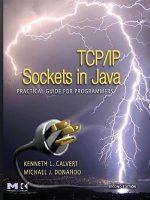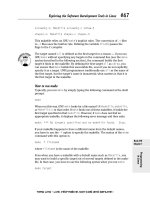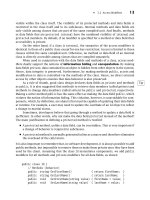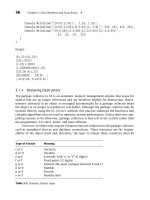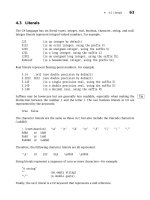TCP/IP Sockets in C# Practical Guide for Programmers phần 10 ppt
Bạn đang xem bản rút gọn của tài liệu. Xem và tải ngay bản đầy đủ của tài liệu tại đây (112.69 KB, 17 trang )
■
5.4 TCP Socket Life Cycle 159
Create new structure and
continue handshake
Underlying implementation
Incoming
connection
request
from
A.B.C.D/P
TcpListener/Socket
Structure
Associated Socket/
TcpClient Structure
Handshake
completes
Local port
Established
Q
A.B.C.D
P
W.X.Y.Z
Local IP
Remote IP
Remote port
Local port
Connecting
Q
A.B.C.D
P
W.X.Y.Z
Local IP
Remote IP
Remote port
ListeningListening
Local port
Listening
Q
*
*
*Local IP
Remote IP
Remote port
Local port Q
*
*
*Local IP
Remote IP
Remote port
Local port Q
*
*
*Local IP
Remote IP
Remote port
Figure 5.8: Incoming connection request processing.
160 Chapter 5: Under the Hood
■
the socket structure of the TcpListener. Note that the TcpListener itself does not change
state, nor does any of its address information change.
In addition to creating a new underlying socket structure, the server-side TCP imple-
mentation sends an acknowledging TCP handshake message back to the client. However,
the server TCP does not consider the handshake complete until the third message of the
3-way handshake is received from the client. When that message eventually arrives, the
new structure’s state is set to “Established,” and it is then (and only then) moved to a list
of socket structures associated with the TcpListener structure, which represent estab-
lished connections ready to be Accept
∗
()ed via the TcpListener. (If the third handshake
message fails to arrive, eventually the “Connecting” structure is deleted.)
Now we can consider (in Figure 5.9) what happens when the server program calls the
TcpListener/ Socket’s Accept
∗
() method. The call unblocks as soon as there is something
in its associated list of socket structures for new connections. (Note that this list may
already be nonempty when Accept
∗
() is called.) At that time, one of the new connection
structures is removed from the list, and an instance of Socket or TcpClient is created for
it and returned as the result of the Accept
∗
().
It is important to note that each structure in the TcpListener’s associated list repre-
sents a fully established TCP connection with a client at the other end. Indeed, the client
can send data as soon as it receives the second message of the opening handshake—which
may be long before the server calls Accept
∗
() to get a Socket instance for it.
5.4.2 Closing a TCP Connection
TCP has a graceful close mechanism that allows applications to terminate a connection
without having to worry about loss of data that might still be in transit. The mechanism
is also designed to allow data transfers in each direction to be terminated independently,
as in the encoding example of Section 4.6. It works like this: the application indicates
that it is finished sending data on a connected socket by calling Close() or by calling
Shutdown(SocketShutdown.Send). At that point, the underlying TCP implementation first
transmits any data remaining in SendQ (subject to available space in RecvQ at the other
end), and then sends a closing TCP handshake message to the other end. This closing hand-
shake message can be thought of as an end-of-transmission marker: it tells the receiving
TCP that no more bytes will be placed in RecvQ. (Note that the closing handshake message
itself is not passed to the receiving application, but that its position in the byte stream
is indicated by Read() returning 0.) The closing TCP waits for an acknowledgment of its
closing handshake message, which indicates that all data sent on the connection made it
safely to RecvQ. Once that acknowledgment is received, the connection is “Half closed.” It
is not completely closed until a symmetric handshake happens in the other direction—that
is, until both ends have indicated that they have no more data to send.
The closing event sequence in TCP can happen in two ways: either one application
calls Close() (or Shutdown(SocketShutdown.Send)) and completes its closing handshake
before the other calls Close(), or both call Close() simultaneously, so that their closing
handshake messages cross in the network. Figure 5.10 shows the sequence of events in
■
5.4 TCP Socket Life Cycle 161
Underlying implementation
Events of
Figure 5.8
TcpListener/Socket
Structure
Associated Socket/
TcpClient Structure
Local port
Connecting
Q
A.B.C.D
P
W.X.Y.Z
Local IP
Remote IP
Remote port
Local port
Listening
Q
*
*
*Local IP
Remote IP
Remote port
Local port
Listening
Q
*
*
*Local IP
Remote IP
Remote port
Local port
Listening
Q
*
*
*Local IP
Remote IP
Remote port
Returns Socket or TcpClient
instance for this structure
Blocks until new
connection is established
Call Accept(), AcceptSocket() or
AcceptTcpClient()
Application
Program
Figure 5.9: Accept
∗
() processing.
162 Chapter 5: Under the Hood
■
Underlying
implementation
Local port
Time-Wait
Q
A.B.C.D
P
W.X.Y.Z
Local IP
Remote IP
Remote port
Returns immediately
Call Close()or
Shutdown(SocketShutdown.Send)
Application
Program
Close
handshake
initiated by
remote
completes
Local port
Established
Q
A.B.C.D
P
W.X.Y.Z
Local IP
Remote IP
Remote port
Local port
Closing
Q
A.B.C.D
P
W.X.Y.Z
Local IP
Remote IP
Remote port
Local port
Half closed
Q
A.B.C.D
P
W.X.Y.Z
Local IP
Remote IP
Remote port
Start
close
handshake
Close
handshake
completes
Figure 5.10: Closing a TCP connection first.
■
5.4 TCP Socket Life Cycle 163
the implementation when the application invokes Close() before the other end closes. The
closing handshake message is sent, the state of the socket structure is set to “Closing,” and
the call returns. After this point, further reads and writes on the Socket are disallowed
(they throw an exception). When the acknowledgment for the close handshake is received,
the state changes to “Half closed,” where it remains until the other end’s close handshake
message is received. Note that if the remote endpoint goes away while the connection is in
this state, the local underlying structure will stay around indefinitely. When the other end’s
close handshake message arrives, an acknowledgment is sent and the state is changed to
“Time-Wait.” Although the corresponding Socket instance in the application program may
have long since vanished, the associated underlying structure continues to exist in the
implementation for a minute or more; the reasons for this are discussed on page 164.
Figure 5.11 shows the simpler sequence of events at the endpoint that does not close
first. When the closing handshake message arrives, an acknowledgment is sent immedi-
ately, and the connection state becomes “Close-Wait.” At this point, we are just waiting for
the application to invoke the Socket’s Close() method. When it does, the final close hand-
shake is initiated and the underlying socket structure is deallocated, although references
to its original Socket instance may persist in the C# program.
In view of the fact that both Close() and Shutdown(SocketShutdown.Send) return
without waiting for the closing handshake to complete, you may wonder how the sender
Underlying
implementation
Local port
Close-Wait
P
W.X.Y.Z
Q
A.B.C.DLocal IP
Remote IP
Remote port
Local port
Established
P
W.X.Y.Z
Q
A.B.C.DLocal IP
Remote IP
Remote port
Returns immediately
Call Close()
Application
Program
Close
handshake
initiated by
remote
completes
Finish close handshake,
delete structure
Figure 5.11: Closing after the other end closes.
164 Chapter 5: Under the Hood
■
can be assured that sent data has actually made it to the receiving program (i.e., to
Delivered). In fact, it is possible for an application to call Close() or Shutdown(Socket-
Shutdown.Send) and have it complete successfully (i.e., not throw an exception) while
there is still data in SendQ. If either end of the connection then crashes before the data
makes it to RecvQ , data may be lost without the sending application knowing about it.
The best solution is to design the application protocol so that the side that calls
Close() first does so only after receiving application-level assurance that its data was
received. For example, when our TCPEchoClient program receives the echoed copy of the
data it sent, there should be nothing more in transit in either direction, so it is safe to
close the connection.
.NET does provide a way to modify the behavior of the Socket’s Close() method,
namely by modifying the linger option. The linger option is accessed by either using
the LingerState property of TcpClient class, or by Socket’s Get/SetSocketOption()
methods. In both cases the LingerOption class is used to control how long Close() waits
for the closing handshake to complete before returning. The LingerOption class takes two
parameters: a Boolean that indicates whether to wait, and an integer specifying the number
of seconds to wait before giving up. That is, when a timeout is specified via LingerOption,
Close() blocks until the closing handshake is completed, or until the specified amount of
time passes.
Here is an example of setting the socket option:
sock.SetSocketOption(SocketOptionLevel.Socket,
SocketOptionName.Linger,
(object)new LingerOption(true, 10));
Here is an example of setting the TcpClient public LingerState property:
client.LingerState = new LingerOption(true, 10);
At the time of this writing, however, Close() provides no indication that the closing
handshake failed to complete, even if the timelimit set by the LingerOption expires before
the closing sequence completes. In other words, using the LingerOption may provide
additional time, but does not provide any additional confirmation to the application in
current implementations.
The final subtlety of closing a TCP connection revolves around the need for the Time-
Wait state. The TCP specification requires that when a connection terminates, at least
one of the sockets persists in the Time-Wait state for a period of time after both closing
handshakes complete. This requirement is motivated by the possibility of messages being
delayed in the network. If both ends’ underlying structures go away as soon as both clos-
ing handshakes complete, and a new connection is immediately established between the
same pair of socket addresses, a message from the previous connection, which happened
to be delayed in the network, could arrive just after the new connection is established.
Because it would contain the same source and destination addresses, the old message
could be mistaken for a message belonging to the new connection, and its data might
(incorrectly) be delivered to the application.
■
5.5 Demultiplexing Demystified 165
Unlikely though this scenario may be, TCP employs multiple mechanisms to prevent
it, including the Time-Wait state. The Time-Wait state ensures that every TCP connection
ends with a quiet time, during which no data is sent. The quiet time is supposed to be
equal to twice the maximum amount of time a packet can remain in the network. Thus, by
the time a connection goes away completely (i.e., the socket structure leaves the Time-Wait
state and is deallocated) and clears the way for a new connection between the same pair of
addresses, no messages from the old instance can still be in the network. In practice, the
length of the quiet time is implementation dependent, because there is no real mechanism
that limits how long a packet can be delayed by the network. Values in use range from
4 minutes down to 30 seconds or even shorter (4 minutes is the default on Microsoft
Windows).
The most important consequence of Time-Wait is that as long as the underlying
socket structure exists, no other socket is permitted to be associated with the same local
port. In particular, any attempt to create a Socket instance using that port will throw a
SocketException with a ErrorCode of 10048 (address already in use).
5.5 Demultiplexing Demystified
The fact that different sockets on the same machine can have the same local address and
port number is implicit in the preceding discussions. For example, on a machine with
only one IP address, every new Socket or TcpClient instance Accept()ed via a server
Socket or TcpListener will have the same local port number as the server socket. Clearly
the process of deciding to which socket an incoming packet should be delivered—that is,
the demultiplexing process—involves looking at more than just the packet’s destination
address and port. Otherwise there could be ambiguity about which socket an incoming
packet is intended for. The process of matching an incoming packet to a socket is actually
the same for both TCP and UDP, and can be summarized by the following points:
■
The local port in the socket structure must match the destination port number in the
incoming packet.
■
Any address fields in the socket structure that contain the wildcard value (
∗
) are
considered to match any value in the corresponding field in the packet.
■
If there is more than one socket structure that matches an incoming packet for all
four address fields, the one that matches using the fewest wildcards gets the packet.
For example, consider a host with two IP addresses, 10.1.2.3 and 192.168.3.2, and
with a subset of its active TCP socket structures, as shown in Figure 5.12. The struc-
ture labeled 0 is associated with a TcpListener and has port 99 with a wildcard local
address. Socket structure 1 is also for a TcpListener on the same port, but with the local
IP address 10.1.2.3 specified (so it will only accept connection requests to that address).
Structure 2 is for a connection that was accepted via the TcpListener for structure 0, and
thus has the same local port number, but also has its local and remote Internet addresses
166 Chapter 5: Under the Hood
■
Local port 99
*
*
*
Listening
Local IP
Remote port
Remote IP
Local port 99
10.1.2.3
*
*
Listening
Local IP
Remote port
Remote IP
Local port 99
192.168.3.2
30001
172.16.1.9
Established
012
Local IP
Remote port
Remote IP
Local port 1025
10.1.2.3
25
10.5.5.8
Established
Local IP
Remote port
Remote IP
…
Figure 5.12: Demultiplexing with multiple matching sockets.
filled in. Other sockets belong to other active connections. Now consider a packet with
source IP address 172.16.1.10, source port 56789, destination IP address 10.1.2.3, and
destination port 99. It will be delivered to the socket associated with structure 1, because
that one matches with the fewest wildcards.
When a program attempts to create a socket with a particular local port number, the
existing sockets are checked to make sure that no socket is already using that local port.
A Socket Bind() will throw an exception if any socket matches the local port and local IP
address (if any) specified. This can cause problems in the following scenario:
1. A client program creates a Socket with a specific local port number, say, P, and uses
it to communicate with a server.
2. The client closes the Socket, and the underlying structure goes into the Time-Wait
state.
3. The client program terminates and is immediately restarted.
If the new incarnation of the client attempts to use the same local port number, the Socket
constructor will throw an SocketException with an ErrorCode of 10048 (address already
in use), because of the other structure in the Time-Wait state.
2
One way to circumvent
this problem is to wait until the underlying structure leaves the Time-Wait state. However,
.NET also permits overriding this behavior by setting the ReuseAddress socket option, but
this is only accessible via the Socket class and not any of the higher level classes:
sock.SetSocketOption(SocketOptionLevel.Socket,
SocketOptionName.ReuseAddress, 1);
So what determines the local/foreign address/port? For a TcpListener, all construc-
tors require that the local port be specified. The local address may be specified to the
constructor; otherwise, the local address is the wildcard (
∗
) address. The foreign address
2
Another scenario that does not require a convergence of several events to encounter this problem
is several multicast receiver clients running on the same host.
■
5.6 Exercises 167
and port for a TcpListener are always wildcards. For a TcpClient, all constructors require
specification of the foreign address and port. The local address and/or port may be spec-
ified to the constructor.
3
Otherwise, the local address is the address of the network
interface through which the connection to the server is established, and the local port
is a randomly selected, unused port number greater than 1023. For a Socket or TcpClient
instance returned by an Accept(), AcceptSocket(),orAcceptTcpClient() call, the local
address is the destination address from the initial handshake message from the client,
the local port is the local port of the server (Socket or TcpListener), and the foreign
address/port is the local address/port of the client. For a UdpClient, the local address
and/or port may be specified to the constructor. Otherwise, the local address is the wild-
card address, and the local port is a randomly selected, unused port number greater
than 1023. The foreign address and port are initially both wildcards and remain that way
unless the Connect() method is invoked to specify particular values.
5.6 Exercises
1. The TCP protocol is designed so that simultaneous connection attempts will succeed.
That is, if an application using port P and Internet address W.X.Y.Z attempts to con-
nect to address A.B.C.D, port Q, at the same time as an application using the same
address and port tries to connect to W.X.Y.Z, port P, they will end up connected to
each other. Can this be made to happen when the programs use the sockets API?
2. The first example of “buffer deadlock” in this chapter involves the programs on both
ends of a connection trying to send large messages. However, this is not necessary
for deadlock. How could the TCPEchoClient from Chapter 2 be made to deadlock
when it connects to the TCPEchoServer from that chapter?
3. Write a version of UnicodeClientNoDeadlock using nonblocking writes (BeginSend()
and EndSend()).
3
This is true for the higher level .NET socket classes but not for the .NET Socket class itself.
This Page Intentionally Left Blank
appendix
Handling Socket Errors
Most of the socket constructors and methods in the .NET library can throw a Socket-
Exception. Unlike some other exception classes in the .NET library, the SocketException
class is fairly generic and requires some additional work to find out what type of error
occurred. SocketException contains two useful properties, Message and ErrorCode. The
Message property contains a human-readable error message. The ErrorCode property con-
tains a WinSock error code from the underlying implementation, and can be used to trap
and handle very specific error conditions.
Table A.1 lists the WinSock error codes that can be retrieved from the ErrorCode
property. The Error Name field is the header constant used with WinSock. These constants
are not accessible within C#, but it is useful to know the constant names because they
are often referenced in WinSock documentation. This table is just a quick reference for
convenience; you should refer to the Microsoft documentation on WinSock error codes at
www.msdn.microsoft.com for more detailed information.
Error Name Value Description
WSAEINTR 10004 Interrupted function call.
WSAEACCES 10013 Permission denied.
WSAEFAULT 10014 Bad address.
WSAEINVAL 10022 Invalid argument.
WSAEMFILE 10024 Too many open files.
WSAEWOULDBLOCK 10035 Resource temporarily unavailable.
WSAEINPROGRESS 10036 Operation now in progress.
WSAEALREADY 10037 Operation already in progress.
Table A.1: Continued
169
170 Appendix: Handling Socket Errors
■
Error Name Value Description
WSAENOTSOCK 10038 Socket operation on nonsocket.
WSAEDESTADDRREQ 10039 Destination address required.
WSAEMSGSIZE 10040 Message too long.
WSAEPROTOTYPE 10041 Protocol wrong type for socket.
WSAENOPROTOOPT 10042 Bad protocol option.
WSAEPROTONOSUPPORT 10043 Protocol not supported.
WSAESOCKTNOSUPPORT 10044 Socket type not supported.
WSAEOPNOTSUPP 10045 Operation not supported.
WSAEPFNOSUPPORT 10046 Protocol family not supported.
WSAEAFNOSUPPORT 10047 Address family not supported by protocol family.
WSAEADDRINUSE 10048 Address already in use.
WSAEADDRNOTAVAIL 10049 Cannot assign requested address.
WSAENETDOWN 10050 Network is down.
WSAENETUNREACH 10051 Network is unreachable.
WSAENETRESET 10052 Network dropped connection on reset.
WSAECONNABORTED 10053 Software caused connection abort.
WSAECONNRESET 10054 Connection reset by peer.
WSAENOBUFS 10055 No buffer space available.
WSAEISCONN 10056 Socket is already connected.
WSAENOTCONN 10057 Socket is not connected.
WSAESHUTDOWN 10058 Cannot send after socket shutdown.
WSAETIMEDOUT 10060 Connection timed out.
WSAECONNREFUSED 10061 Connection refused.
WSAEHOSTDOWN 10064 Host is down.
WSAEHOSTUNREACH 10065 No route to host.
WSAEPROCLIM 10067 Too many processes.
WSASYSNOTREADY 10091 Network subsystem is unavailable.
WSAVERNOTSUPPORTED 10092 Winsock.dll version out of range.
WSANOTINITIALIZED 10093 Successful WSAStartup not yet performed.
WSAEDISCON 10101 Graceful shutdown in progress.
WSATYPE_NOT_FOUND 10109 Class type not found.
WSAHOST_NOT_FOUND 11001 Host not found.
WSATRY_AGAIN 11002 Nonauthoritative host not found.
WSANO_RECOVERY 11003 This is a nonrecoverable error.
WSANO_DATA 11004 Valid name, no data record of requested type.
WSA_INVALID_HANDLE OS dependent Specified event object handle is invalid.
WSA_INVALID_PARAMETER OS dependent One or more parameters are invalid.
WSA_IO_INCOMPLETE OS dependent Overlapped I/O event object not in signaled state.
WSA_IO_PENDING OS dependent Overlapped operations will complete later.
WSA_NOT_ENOUGH_MEMORY OS dependent Insufficient memory available.
WSA_OPERATION_ABORTED OS dependent Overlapped operation aborted.
WSAINVALIDPROCTABLE OS dependent Invalid procedure table from service provider.
WSAINVALIDPROVIDER OS dependent Invalid service provider version number.
WSAPROVIDERFAILEDINIT OS dependent Unable to initialize a service provider.
WSASYSCALLFAILURE OS dependent System call failure.
Table A.1: WinSock Error Codes
Bibliography
[1] Case, J. D., Fedor, M., and Schoffstall, M. L. “Simple Network Management Protocol
(SNMP).” Internet Request for Comments 1157, May 1990.
[2] Comer, Douglas E. Internetworking with TCP/IP, volume 1, Principles, Protocols, and
Architecture (third edition). Upper Saddle River, NJ: Prentice-Hall, 1995.
[3] Comer, Douglas E., and Stevens, David L. Internetworking with TCP/IP, volume 2,
Design, Implementation, and Internals (third edition). Upper Saddle River, NJ:
Prentice-Hall, 1999.
[4] Comer, Douglas E., and Stevens, David L. Internetworking with TCP/IP, volume 3,
Client-Server Programming and Applications (BSD version, second edition). Upper
Saddle River, NJ: Prentice-Hall, 1996.
[5] Deering, S., and Hinden, R. “Internet Protocol, Version 6 (IPv6) Specification.” Internet
Request for Comments 2460, December 1998.
[6] Gilligan, R., Thomson, S., Bound, J., and Stevens, W. “Basic Socket Interface
Extensions for IPv6.” Internet Request for Comments 2553, March 1999.
[7] International Organization for Standardization. Basic Encoding Information Process-
ing Systems: Open Systems Interconnection—Specification of Abstract Syntax Notation
One (ASN.1). International Standard 8824, December 1987.
[8] Mockapetris, Paul. “Domain Names: Concepts and Facilities.” Internet Request for
Comments 1034, November 1987.
[9] Mockapetris, Paul. “Domain Names: Implementation and Specification.” Internet
Request for Comments 1035, November 1987.
171
172 Bibliography
■
[10] Peterson, Larry L., and Davie, Bruce S. Computer Networks: A Systems Approach
(second edition). San Francisco: Morgan Kaufmann, 2000.
[11] Postel, John. “Internet Protocol.” Internet Request for Comments 791, September
1981.
[12] Postel, John. “Transmission Control Protocol.” Internet Request for Comments 793,
September 1981.
[13] Postel, John. “User Datagram Protocol.” Internet Request for Comments 768, August
1980.
[14] Steedman, Douglas. Abstract Syntax Notation One (ASN.1): The Tutorial and Refer-
ence. London, U.K.: Technology Appraisals, 1990.
[15] Stevens, W. Richard. TCP/IP Illustrated, volume 1, The Protocols. Reading, MA:
Addison-Wesley, 1994.
[16] Stevens, W. Richard. UNIX Network Programming: Networking APIs: Sockets and XTI
(second edition). Upper Saddle River, NJ: Prentice-Hall, 1997.
[17] Sun Microsystems, Incorporated. “External Data Representation Standard.” Internet
Request for Comments 1014, June 1987.
[18] Sun Microsystems, Incorporated. “Network File System Protocol Specification.”
Internet Request for Comments 1094, March 1989.
[19] Sun Microsystems, Incorporated. “Network File System Protocol Version 3 Specifica-
tion.” Internet Request for Comments 1813, June 1995.
[20] Wright, Gary R., and Stevens, W. Richard. TCP/IP Illustrated, volume 2, The
Implementation. Reading, MA: Addison-Wesley, 1995.
[21] Krowczyk, A., Kumar, V., Laghari, N., Mungale, A., Nagel, C., Parker, T., and
Sivakumar, S. .NET Network Programming. Birmingham, U.K.: Wrox Press Ltd, 2002.
[22] Quinn, B., and Shute, D. Windows Sockets Network Programming. Reading, MA:
Addison-Wesley, 1995.
[23] The Unicode Consortium. The Unicode Standard, Version 3. Reading, MA: Addison-
Wesley, Longman, 2000.
[24] Donahoo, M., and Calvert, K. TCP/IP Sockets in C: Practical Guide for Programmers.
San Francisco: Morgan Kaufmann, 2001.
[25] Calvert, K., and Donahoo, M. TCP/IP Sockets in Java: Practical Guide for Programmers.
San Francisco: Morgan Kaufmann, 2002.
[26] Makofske, D., and Almeroth, K. Multicast Sockets: Practical Guide for Programmers.
San Francisco: Morgan Kaufmann, 2002.
[27] Braden, R. “Requirements for Internet Hosts—Communications Layers.” Internet
Request for Comments 1122, October 1989.
[28] Braden, R. “Requirements for Internet Hosts—Application and Support.” Internet
Request for Comments 1123, October 1989.
Index
A
Addresses
definition of, 3–4
destination, 9
directed broadcast, 132
sockets, 9–15
ANSII, 62
Application, 5
Application programming
interface
asynchronous, 119
description of, 16
Application protocols, 3, 59
Asynchronous I/O, 117–131
B
Binary numbers, 63–65
BinaryWriter, 64–65
Blocking calls with timeout,
88–92
Boolean values, 71
Broadcast, 132
Buffer, 20
Buffer deadlock, 152–154
Buffering, 149–152
Bytes
definition of, 61
order of, 63
C
Callback, 117
Clients
description of, 5–6
TCP, 17–23
UDP, 29–32
Closing connections
description of, 138–145
TCP, 160–165
Communication channel, 1–2
Connection-oriented
protocol, 3
ConsoleLogger, 105–106
D
Datagram service, 3
Datagram sockets, 6
Deadlock, 152–154
Delegate, 117
Delimiter, 67
Demultiplexing, 165–167
Descriptor, 7
Destination address, 9
Directory services, 6
DNS, see Domain name system
Dns class, 9–10
Domain name system, 5
Domain names, 5
Dotted-quad notation, 4
E
EBCDIC, 63
EchoProtocol, 103–105
EchoProtocolFactory,
110–111
Encoding of information
binary numbers, 63–65
description of, 61
framing, 66–70
parsing, 66–70
text, 61–63
End call, 117
End-to-end transport
protocols, 3
Errors, sockets, 169–170
Extended Binary Coded
Decimal Interchange
Code, 63
F
Factoring of servers, 109–112
Factory object, 109
Fields, 59
FileLogger, 106–107
First-in, first-out queue, 36
Framer, 68–70
Framing, 66–70
H
Handshake messages, 3
Hosts
definition of, 1–2
names of, 5
Hypertext Transfer Protocol, 2
I
IDispatcher, 111
173
174 Index
■
ILogger, 105
Information encoding
binary numbers, 63–65
description of, 61
framing, 66–70
parsing, 66–70
text, 61–63
Integers
signed, 63
size of, 63
Internet address, 4
I/O
asynchronous, 117–131
nonblocking, 85–95
status prechecking, 86–88
streams, 65–66
IPAddressExample.cs, 10–15
IProtocol, 103
IProtocolFactory, 110
ItemQuote, 60–61
ItemQuoteBinConst, 75–77
ItemQuoteDecoder,70
ItemQuoteDecoderBin, 77–79
ItemQuoteDecoderText, 73–74
ItemQuoteEncoder,70
ItemQuoteEncoderText, 72–73
ItemQuoteTextConst, 71–72
Iterative server, 99
L
Layers
definition of, 2
network, 2
transport, 3
M
MCIPAddress, 133
Messages, 59
Microseconds, 88
Mode, 88
Multicast
definition of, 132–133
receivers, 137
senders, 135
Multicast group, 135
Multiplexing, 95–99
N
Names, 5
.NET
description of, 9
encoding of information,
62
I/O streams, 65–66
serialization capabilities
of, 83–84
socket implementation in,
15–16
Network byte order, 63
Network layer, 2
Nonblocking I/O, 85–95
Nonblocking sockets, 92–95
P
Packets, 2
Parsing, 66–70
Peer, 5
Polling, 89
PoolDispatcher, 113–115
Port number, 4
Port numbers, 3, 6
Protocol(s)
application, 3
connection-oriented, 3
definition of, 2
layers of, 2
organizing of, 2
Protocol suite, 2
R
RecvQ, 150–152, 155
RecvTcp, 81–82
RecvUdp,83
RecvUDPMulticast, 135–137
Routers
definition of, 1
function of, 2
S
SendQ, 150, 152, 155
SendTcp, 79–81
SendUdp,82
SendUDPMulticast, 133–135
Serializable,84
Serialization, 83–84
Servers
construction of, 23–27
description of, 5–6
factoring of, 109–112
iterative, 99
TCP, 23–27, 40–50
thread-per-client,
107–109
UDP, 32–36
Signed integers, 63
Socket(s)
addresses, 9–15
closing of, 138–145
data structures associated
with, 148f
datagram, 6
definition of, 6, 16
demultiplexing with,
165–167
errors, 169–170
in .NET, 15–16
nonblocking, 92–95
schematic diagram of, 7f
server-side, 157f
stream, 6
structure of, 149
TCP, see TCP sockets
types of, 6
UDP, see UDP sockets
Socket, 43–46
Socket flags, 56–57
Socket options, 51–56
SocketException,50
SocketFlags,47
SocketOptionLevel, 46,
48–49
SocketOptionName,47
SocketSelect(), 95–99
Stream(s)
description of, 28
I/O, 65–66
Stream sockets, 6
System.Runtime.Serializable,
84
System.Text,62
System.Xml.Serializable,
83–84
T
TCP client
connecting of, 156–160
description of, 17–23
with socket, 37–39
TCP connection, 17
TCP server
description of, 23–27
with socket, 40–50
■
Index 175
TCP sockets
buffering, 149–152
closing of, 160–165
description of, 16–17
life cycle of, 155–165
performance of, 154–155
UDP sockets vs., 29
TcpClient, 16, 21–23
TcpClientShutdown, 140–141
TcpEchoClient, 17–23
TcpEchoClientAsync, 120–125
TcpEchoClientSocket, 37–39
TcpEchoServer, 24–26
TcpEchoServerAsync, 125–131
TcpEchoServerSelectSocket,
96–99
TcpEchoServerSocket, 40–50
TcpEchoServerThread,
108–109
TcpEchoServerTimeout, 89–92
TcpListener, 16, 26–27
TcpListenerAcceptSocket,
50–51
TcpNBEchoClient, 93–95
Text, 61–63
Text-oriented representation,
71
TextReader,67
Thread(s)
deadlock avoidance, 154
description of, 99–103
thread-per-client servers,
107–109
Thread pool, 112–116
ThreadExample, 101–103
ThreadMain, 115–116
ThreadPerDispatcher,
111–112
3-way handshake, 156
Timeout, blocking calls with,
88–92
TranscodeClient, 141–143
TranscodeServer, 143–145
Transport layer, 3
U
UDP client, 29–32
UDP servers, 32–36
UDP sockets
description of, 29
receiving with, 36
sending with, 36
TCP sockets vs., 29
UdpClient, 35–36
UdpEchoClient, 30–32, 52
UdpEchoClientTimeoutSocket,
53–56
UdpEchoServer, 33–35
Unicast
definition of, 131
receivers, 137
senders, 135
Universal resource locator, 6
URL, see Universal resource
locator
W
Wire formats
combined data
representation, 75–79
description of, 70–75
sending and receiving,
79–83
X
XML, 84


